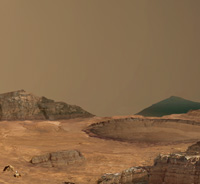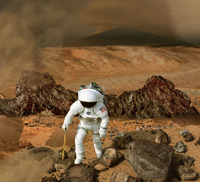| Goals |
 |
New knowledge from the twin rovers will uniquely contribute to meeting the four overarching goals of the Mars Exploration Program, while complementing data gathered through other Mars missions:
Goal 1: Determine whether Life ever arose on Mars
[more on Goal 1 for the entire Mars Exploration Program]
 Life, as we understand it, requires water, so the history of water
on Mars is critical to finding out if the martian environment was ever conducive to life.
Although the Mars Exploration Rovers do not have the ability to detect life directly, they will be offering very important information on the habitability of the environment in the planet´s history. The rovers will focus on questions concerning
water on Mars: its past, where it was located, and the chemical
and geological interactions with the rocks and soil. Close-up
studies of surface samples will reveal new details of Mars
mineralogy that may help answer whether water was involved in rock and
soil formation, and the nature of those processes.
This knowledge, in turn, will point the way to areas on Mars that
may have been favorable for life in the past.
Life, as we understand it, requires water, so the history of water
on Mars is critical to finding out if the martian environment was ever conducive to life.
Although the Mars Exploration Rovers do not have the ability to detect life directly, they will be offering very important information on the habitability of the environment in the planet´s history. The rovers will focus on questions concerning
water on Mars: its past, where it was located, and the chemical
and geological interactions with the rocks and soil. Close-up
studies of surface samples will reveal new details of Mars
mineralogy that may help answer whether water was involved in rock and
soil formation, and the nature of those processes.
This knowledge, in turn, will point the way to areas on Mars that
may have been favorable for life in the past.
Goal 2: Characterize the Climate of Mars
[more on Goal 2 for the entire Mars Exploration Program]
 Recorded in the structure and mineral content of Mars' rocks and
soils are signs of the environmental conditions under which the
materials were formed and altered. Detailed studies of rock
samples with the rover instruments will reveal climate details
of Mars´ past, which may have been warmer and wetter. In addition, one science instrument
will periodically look up to gather temperature profiles of the
atmospheric boundary layer - the layer of atmosphere
from the surface up to 10 kilometers (6 miles) in altitude.
This part of the atmosphere cannot be well observed
by orbital instruments, and the data returned will provide
important basic information for understanding the current
climate on Mars.
Recorded in the structure and mineral content of Mars' rocks and
soils are signs of the environmental conditions under which the
materials were formed and altered. Detailed studies of rock
samples with the rover instruments will reveal climate details
of Mars´ past, which may have been warmer and wetter. In addition, one science instrument
will periodically look up to gather temperature profiles of the
atmospheric boundary layer - the layer of atmosphere
from the surface up to 10 kilometers (6 miles) in altitude.
This part of the atmosphere cannot be well observed
by orbital instruments, and the data returned will provide
important basic information for understanding the current
climate on Mars.
Goal 3: Characterize the Geology of Mars
[more on Goal 3 for the entire Mars Exploration Program]
 The rovers are equipped with some of the tools a geologist would
carry into the field, as well as the scientific instruments
a geologist would use in a lab to study collected samples.
Detailed mineralogical study of rock samples will reveal their
content and the conditions in which they formed. A tool to scrape
away weathered surfaces of rocks will expose fresh surfaces for
close-up study.
The rovers are equipped with some of the tools a geologist would
carry into the field, as well as the scientific instruments
a geologist would use in a lab to study collected samples.
Detailed mineralogical study of rock samples will reveal their
content and the conditions in which they formed. A tool to scrape
away weathered surfaces of rocks will expose fresh surfaces for
close-up study.
Of particular interest to the rover science team are minerals containing the element iron, which interacts strongly with liquid water. Did the
reddish Martian soil form billions of years ago when the planet may have been wetter
and warmer, or is the rusty soil simply the result of ongoing interaction of
an oxidizing atmosphere with the surface rocks? Other searches for geological evidence of water will be for clays,
carbonates, salts and other minerals that formed in the presence of water.
The local measurements made by the rovers at two landing sites
will be used to calibrate similar measurements made from orbit, so
that we can extend what we learn to larger regions of Mars.
Goal 4: Prepare for Human Exploration
[more on Goal 4 for the entire Mars Exploration Program]
 The Mars Exploration Rovers will characterize the chemistry and mineralogy of the
Martian soil and dust, and perhaps some of the potential hazards that they may
pose to humans. Through its studies of surface mineralogy, the mission
will help in the assessment of soil and rock as potential in-situ
resources for future human missions. The rovers will also contribute to
studies of how well the rovers can traverse given characteristics of the
soil (for instance, how much resistance the soil provides, how far down
the wheels sink etc.). This knowledge will help in planning for other
future vehicles that might be needed on Mars.
The Mars Exploration Rovers will characterize the chemistry and mineralogy of the
Martian soil and dust, and perhaps some of the potential hazards that they may
pose to humans. Through its studies of surface mineralogy, the mission
will help in the assessment of soil and rock as potential in-situ
resources for future human missions. The rovers will also contribute to
studies of how well the rovers can traverse given characteristics of the
soil (for instance, how much resistance the soil provides, how far down
the wheels sink etc.). This knowledge will help in planning for other
future vehicles that might be needed on Mars.
|